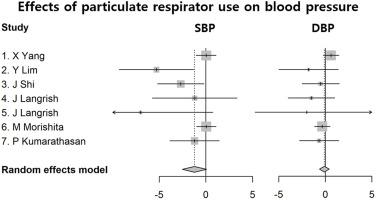Environmental Pollution ( IF 8.9 ) Pub Date : 2021-06-11 , DOI: 10.1016/j.envpol.2021.117574 Changwoo Han 1 , Youn-Hee Lim 2 , Yun-Chul Hong 3

|
People use a particulate respirator in order to reduce exposure to ambient fine particulate matter (PM2.5). Acute exposure to PM2.5 is known to increase blood pressure. However, systematic reviews or meta-analyses on blood pressure-related benefits of using a particulate respirator is lacking. Therefore, we reviewed randomized crossover intervention studies on blood pressure-related effects of particulate matter respirator use. We conducted a literature review of articles found on Embase, Medline, and Cochrane library on August 31, 2020. The study outcomes were systolic and diastolic blood pressure and mean arterial pressure. A random-effect model was used in the meta-analysis. Subgroup analyses, based on age (adult < 60 years, elderly ≥ 60 years), personal PM2.5 exposure levels (High: ≥ 25 μg/m3, Low: < 25 μg/m3), and types of monitoring methods (ambulatory and resting blood pressure) were conducted. We identified 297 references, and seven studies were included in our systematic review. None of the studies used a sham respirator as control and complete allocation concealment and blinding were impossible. The use of a particulate respirator was associated with a −1.23 mmHg (95% confidence interval (CI): −2.53, 0.07) change in systolic blood pressure and a −1.57 mmHg (95% CI: −3.85, 0.71) change in mean arterial pressure. There were significant heterogeneities and possibilities for publication bias. The subgroup analyses revealed that studies involving elderly individuals, those conducted in high PM2.5 personal exposure, and those in which resting blood pressure was monitored demonstrated a larger decrease in blood pressure resulting from respirator use. Further intervention studies with a large sample size and subjects with diverse characteristics and different personal PM2.5 levels may add the evidence to current literature.
中文翻译:

微粒呼吸器的使用和血压:系统评价和荟萃分析
人们使用颗粒物呼吸器以减少暴露于环境细颗粒物 (PM 2.5 )。众所周知,急性暴露于 PM 2.5会增加血压。然而,缺乏关于使用微粒呼吸器的血压相关益处的系统评价或荟萃分析。因此,我们回顾了关于使用颗粒物呼吸器对血压相关影响的随机交叉干预研究。我们对 2020 年 8 月 31 日在 Embase、Medline 和 Cochrane 图书馆中发现的文章进行了文献综述。研究结果是收缩压和舒张压以及平均动脉压。荟萃分析中使用了随机效应模型。亚组分析,基于年龄(成人 < 60 岁,老年人 ≥ 60 岁),个人 PM 2.5进行了暴露水平(高:≥ 25 μg/m 3,低:< 25 μg/m 3)和监测方法类型(动态血压和静息血压)。我们确定了 297 篇参考文献,其中 7 项研究被纳入我们的系统评价。没有一项研究使用假呼吸器作为对照,完全分配隐藏和盲法是不可能的。微粒呼吸器的使用与 -1.23 mmHg(95% 置信区间(CI):-2.53, 0.07)收缩压变化和 -1.57 mmHg(95% CI:-3.85, 0.71)平均变化相关动脉压。存在显着的异质性和发表偏倚的可能性。亚组分析显示,涉及老年人的研究,那些在高 PM 2.5个人接触和监测静息血压的人表明使用呼吸器导致血压下降幅度更大。进一步的大样本干预研究和具有不同特征和不同个人 PM 2.5水平的受试者可能会为当前文献增加证据。



























 京公网安备 11010802027423号
京公网安备 11010802027423号